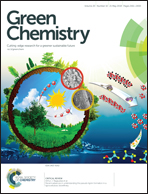Enhanced photostability of cuprous oxide by lignin films on glassy carbon electrodes in the transformation of carbon dioxide†
Abstract
Photoelectrochemical reduction of CO2 was investigated on carbon electrodes modified with lignin and cuprous oxide. The electrodes were modified by electropolymerization of lignin and subsequent pulse electrodeposition of Cu2O. Characterization of the electrodes was performed by SEM microscopy, Raman, IR-ATR and UV-visible spectroscopies, as well as electrochemical methods. Lignin films provide a micro-environment where Cu2O is stabilized and also its reactivity is modified toward C–H–O containing compounds. The main products obtained from the reduction of CO2 are formaldehyde, methyl formate and ethyl acetate, as detected and quantified by nuclear magnetic resonance and UV-Vis spectroscopy. Our results demonstrate that lignin is a good material for the formation and support of the electrodeposited Cu2O, where the Cu2O enables the potential use of solar energy for the photoelectrochemical reduction of CO2 at low overpotentials.



 Please wait while we load your content...
Please wait while we load your content...
